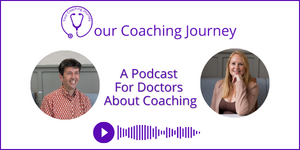Prefer to listen?
This blog post forms the basis of a podcast on our new coaching model, which you can listen to here.
What Is Somatic Coaching?
A fairly literal translation, from the Greek word ’soma’ for body, is ‘body coaching’. In Somatic Coaching we’re using the body within our coaching. It’s a holistic approach that has the intention of raising a coachee’s awareness of their body and the messages that are coming from it. It’s (re)introducing them to their body and getting them reflect on aspects of their physiology that could be useful to them in working out whatever is right for them.
It’s focussing on the mind-body connection.
Coach training is typically about the conversation, the exchange of words. And there may be some resistance to somatic coaching because it’s not about thinking. It can also seem to be quite extreme as Tom discovered.
Tom’s journey with coaching started with the conversation, and the thinking mind. He then read Richard Strozzi-Heckler’s book, The Art of Somatic Coaching. His concept of Somatic Coaching was about the whole lifestyle. He introduced elements of aikido, and it was suggested that you had to learn aikido, or something similar, and practice it every day in order to be a somatic coach. He is renowned for this style of coaching, but it seems quite inaccessible for many, and was definitely a barrier for Tom. After that he came across the work of Antonio Damasio, a Portuguese neuroscientist who studied the somatic markers that we have in our body that will give us information. That made more sense to him because it still connected to and with the brain.
Whereas Helen’s journey with coaching and somatic coaching was very integrated from the start. The embodiment, or somatic work was in fact, an important aspect of her training. She did a week long intensive to start her coach training and almost every evening, would do some somatic work around what they had learned during the day; how things felt in their bodies, and how they could utilise that mind-body connection to find new ways of being. Helen continues to use this type of coaching as an important element of her work.
Where Did Somatic Coaching Start?
It started during the 20th century with Wilhelm Reich and a Moshe Feldenkrais. Reich was a student of Freud and he explored the connection between emotional experiences and the body; what was going on for people, and what was held in the body. He described things, like emotions, that people held onto, as ‘character armour’. He said they would build up an armour around difficult emotions.
Feldenkrais developed the Feldenkrais method, which was all about the structure of the body, how we hold ourselves, posture, and psychological states. In the ’70s, Thomas Hanna popularised the term ‘somatics’, emphasising the importance of body awareness and movement to try and achieve some holistic health. And that laid the foundations for somatic coaching.
It seems that Richard Strozzi-Hekler introduced the idea of somatics within the coaching world. It probably existed in other ways, but we think he was the first one to actually call it ‘somatic coaching’. For him, there was definitely a link to a very Californian way of life.
To be clear, we don’t believe that you need to practise aikido every day in order to do somatic coaching.
Some more people to look out for in this field are:
There’s a coach called Amanda Blake who does a lot of work in this arena. She was a student of Strozzie-Heckler, and has carried on that exploration of scientifically grounded, mind-body approaches to leadership.
Helen’s tutor, Susie Heath is a phenomenal, UK based embodiment trainer and relationship coach.

Helen Says:
“For many people, especially, women, there’s such a detachment between their thinking and their bodies. There’s so much discussion that could be had around that.
It’s so important to reconnect with our bodies, to get out of our mind and back ‘into’ our bodies, to own the space that we take up in the world and not be afraid of that. I think somatic coaching and embodied coaching has a really important role in helping women to feel empowered”
Somatics Within Other Approaches To Coaching
If you have a bit of a resistance to being a somatic coach, as Tom did initially, then it’s worth considering the different coaching approaches that use some elements of somatics. Certainly within our transformational coaching diploma we look at different approaches that use somatics. It might be as simple as noticing someone’s gestures or body language when they talk about a particular thing.
Gestalt coaching uses the body; It’s about noticing what you’re noticing, and the coachee noticing what they’re noticing about what’s going on in their body, and where they are feeling things. Also, in terms of Gestalt, you might pick up on gestures that someone is making whilst they’re talking about something. You might ask them to talk about it again, but to exaggerate the gestures, just to bring it more into their awareness. Whilst they’re talking about a conversation with a particular person, if their posture changes to make themselves smaller, you might, for example, get them to scrunch up even tighter and talk about it again, or you might get them to throw their shoulders back, stretch their arms out and talk about it again, and to completely change their posture. And to notice how that changes how they feel about it.
If you think about the Cognitive Behavioural coaching approach, and the hot cross bun model or the SPACE model, whichever you prefer to call it, there’s the physiological aspect. Quite often, it’s not just the physiology of the body, but the feelings in the body that people notice, including their posture. We could say, “I noticed when you talk about this, you did that. What does that mean?” And if we’re looking at someone’s thoughts and emotions and actions, we could also encourage them to then think about, “where do you hold that?” or “Where does that exist for you?”
Tapping into physiology and being able to shift the physiology is often a quick(er) hack to behaviour change, because it’s probably easier to shift your posture than to shift your thinking in the moment, if you can remember to do either. We’re very interested in Amy Cuddy’s work and that idea of power posing and changing your posture to bring about a different state. That, again, feeds into this, that if we can ask someone to adopt a different posture, to try it out for size, to see how it feels, and perhaps bring some of that to their interactions in certain situations and to explore how it feels and what changes. This is something Helen does regularly with clients, with really positive feedback and outcomes.
Even if we’re not taking an entirely somatic approach, some somatic awareness and helping to make someone more aware of what you are noticing, encouraging them to notice what is happening physiologically for them, increasing their awareness of what’s going on in their body and where, perhaps, certain feelings show up, can be really useful.
What One Somatic Technique Could You Try?
The gentlest way into somatic work is just to notice what you’re noticing, to become more aware of what’s going on for the coachee in front of you, and perhaps explore that with them. If we think about using a Cognitive Behavioural approach, asking where someone’s feeling is held and what it feels like? You might find a metaphor comes up for them in terms of what’s going on for them in their body, and that’s worth exploring
What Else Could You Try?
Helen says,
“the most powerful intervention, I would say, is to get people out of their seats. I know there are lots of coaches that do walking coaching and outdoor coaching, but even if we are on Zoom with someone, to get someone out of their seats and standing and exploring what things feel like, if it’s a habit, how does your body feel when you’re about to do this thing? Or if it’s something around confidence, how does your body feel when you go into that space? Then we explore different ways of moving the body and how that changes people’s feelings and thinking, and really looking for ways that we can work with it when they go back into those spaces. So really tapping into the body and getting people out of their seats and standing and exploring how perhaps they could shift their physicality to help them with what they want to achieve.
If they want to be someone who isn’t scared, is confident, takes up space in the world, whether that’s in a leadership role or whatever role they take, they might need permission to do that. We can give them that. Sometimes, it’s important to get out of the seat and feel it first in the coaching space is where it’s safe to practise that with me. And as a coach, I go there with them. I don’t sit and watch the screen. If I get them out of their seats, I get out of my seat with them. That’s something I think that’s really important; let’s do this together. We’re not going to experience the same things, but I’m going to go there with you. That makes people feel more comfortable and psychologically safe to do that.”
And this is something we explore on our coach training as well.
What are the benefits to using a somatic approach?
We believe that the benefits can be far-reaching and more holistic, they will, as with most of the work we do, ripple out into everything else around the coachee. Working in a somatic way seems to encourage:
- an increased sense of well-being,
- an increase in positive emotions,
- being more in the moment,
- being more mindful
- stress relief.
There’s also something about becoming more yourself. It’s almost like when we disconnect from their bodies, we lose a part of ourselves. When we can reconnect with that part of ourselves, we become more whole and we become who we truly are.
There’s so much more we could say about somatic coaching, but we hope this gives you a taster of it. We think that to ignore the somatic element of coaching would be a mistake. We have to have some awareness of it and we hope that you feel it’s worth exploring. Try working in different ways with clients and just seeing what it brings up. Some people will connect with it without more than others, so give it a go and see what happens.
We do cover the mind body connection, and somatics on our coach training programme.
You can find out more about our Transformational Coaching Diploma here.



